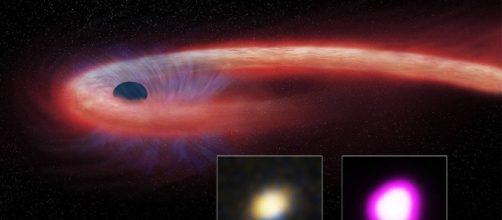Astronomers recorded the disruptions caused by a star when it gets absorbed by the tidal forces (TDE) of a Black Hole. Utilising the Palomar Observatory, scientists detected eruptions of radiation in two distinct events. One of them being the nearest at 66.6 Mpc, providing astronomers with the best chances for observation and study. These types of events are real evidence of very strong gravity and accretion disks that may provide new information about the formation of supermassive black holes (BH).
Tidal disruption events (TDE)
This is an astronomical event that occurs every time a star gets in the vicinity of a supermassive black hole´s event horizon.
When it does, it is disrupted by the tidal forces of the BH, experiencing spaghettification. The torn apart star begins to fall down towards the centre of the BH and this is when radiation starts to appear at the very centre of the accreting disk. Revealing that a tidal disruption event is taking place. It’s believed that the radiation at the centre of an accretion disk could be the sign of a dormant BH.
Two most recent TDE
The first identified TDE was detected in the 1990s and it was done so by the bright X-rays it ejected. Subsequent observations of the same phenomenon were done using the Palomar Observatory. On August 29016, astronomers reported two distinct TDE known as iPTF16axa and iPTF16fnl, respectively.
The first TDE was discovered 49 days after the disruption and it revealed a constant temperature of 39,999 K. That BH in which this event occurred is estimated to be 40 million times the mass of the sun. Supermassive black holes are believed to lie at the centre of every galaxy in the universe.
Follow-up investigations
Scientists used NASA´s Swift Space Observatory and other ground-based observatories to improve their knowledge about the evolution of these two latest events.
The information provided by Swift permitted to exclude the possibility that the radiation could have been produced by the active centre of a galaxy. On the other hand, iPTF16fnl is located in a galaxy known as Markarian 950 and in a less massive BH only 2 million solar masses. , making it the TDE that occurs in a BH with the lowest mass detected to date.

